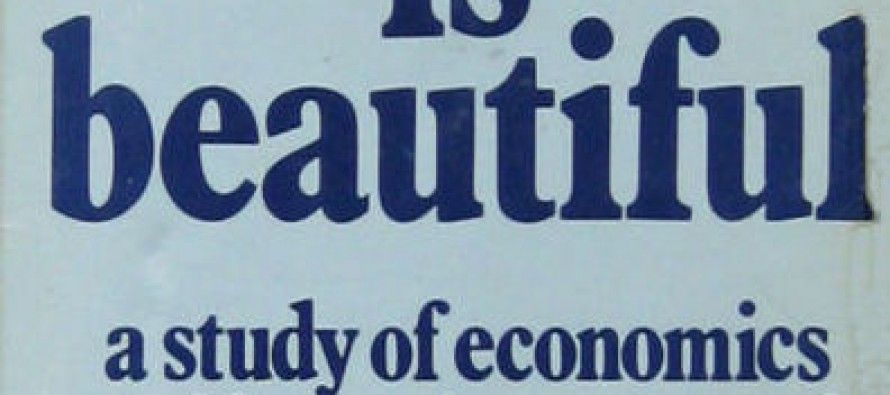Will Gov. Brown’s ‘small is beautiful’ sink water plan?

 During California Gov. Jerry Brown’s first term in office, 1975 to 1983, one of the central planks of his political platform was “small is beautiful.” Brown borrowed his platform from economist E.F. Schumacher’s 1973 book, “Small is Beautiful: Economics as if People Mattered.”
During California Gov. Jerry Brown’s first term in office, 1975 to 1983, one of the central planks of his political platform was “small is beautiful.” Brown borrowed his platform from economist E.F. Schumacher’s 1973 book, “Small is Beautiful: Economics as if People Mattered.”
As the publisher’s blurb now describes it:
“A landmark statement against ‘bigger is better’ industrialism, Schumacher’s Small Is Beautiful paved the way for twenty-first century books on environmentalism and economics, like Jeffrey Sachs’s The End of Poverty, Paul Hawken’s Natural Capitalism, Mohammad Yunis’s Banker to the Poor, and Bill McKibben’s Deep Economy. This timely reissue offers a crucial message for the modern world struggling to balance economic growth with the human costs of globalization.”
Fast forward to 2013, and Brown is poised to push through his more than $50 billion package of big water projects: a Delta Twin Tunnels Plan, a Delta Conservation Plan, a Delta Levee improvement project, and a downsized statewide water bond requiring voter approval. One of the surprising changes in public opinion that may present an obstacle with voters to Brown’s water plan is the “small is beautiful” movement that paradoxically he made popular with many Californians.
Some writers have called Brown’s “small is beautiful” philosophy “prescient,” indicating insight about the future. A recent study by UCLA’s Center of the Environment and Sustainability seems to have fulfilled Brown’s prophecy. The study has captivated the public with the idea that solar photovoltaic panels on just 5 percent of Southern California’s buildings could produce half the electricity needed statewide.
The study goes so far as to list the precise building addresses that would generate the highest electricity output. Certainly those property owners will now look to the potential revenues from lucrative solar farms on their rooftops as part of their entitlement of property rights. Many upper-middle-class homeowners in California have already bought into the notion of their right to subsidized rooftop solar power. This is despite California’s “One Million Roofs” program being overhyped and underperforming and costing other electric ratepayers $1.1 billion in extra costs.
Ad campaign by solar power industry
This burgeoning “small is beautiful” movement cuts across the political spectrum. It has excited those on the politically left Occupy Movement who disdain big utilities and big banks. It also lured conservative Republicans and Tea Partiers into endorsing rooftop solar projects, even though the devices require huge subsidies and add to the national debt.
Conservative Republican Barry Goldwater Jr. has founded a lobbying group in Arizona called Tell Utilities Solar Won’t Be Killed — T.U.S.K. The former chairperson of the Republican Party in Arizona, Robert Morrissey, has joined the group. In California, this campaign has tried to co-opt the Tea Party into an alliance with the Sierra Club.
PR campaigns portray green power as patriotic, Biblical and as American as apple pie, the American flag and Mom.
The Obama administration’s scandals with big solar panel manufacturers like Solyndra in California have caused some in Congress to threaten cutting solar-energy tax credits. To counter the threat, the solar industry is trying to gain public legitimacy by portraying itself as small, beautiful and uncorrupted.
But what does all this “small is beautiful” marketing effort by the solar and wind energy industries have to do with Jerry Brown’s water plan? Plenty.
Small Water vs. Big Ag and Big Tunnels
The UCLA study goes so far as to propose cutting Los Angeles off of dependence of imported water from the huge California State Water Project and the even larger federal Central Valley Project. Under preliminary plans being floated by the UCLA Luskin Center, Los Angeles instead would rely on ocean water desalting plants, the recharging of local groundwater basins with recycled water and rainwater harvesting. To get the public to cut its dependence on imported water, big corporate agriculture and Brown’s Big Tunnels project would have to be demonized.
Forget the reality of 8 to 10 year droughts that sometimes hit Southern California. Forget the reality that two-thirds of its allotment of Colorado River Aqueduct water has been curtailed to Southern Californians in recent years. Forget that 65 percent of Southern California’s allocation of water from the California Aqueduct has been curtailed due to lawsuits to protect fish. Forget the consequences to California’s agricultural industry. Big is bad and small is beautiful is the message being successfully implanted in the receptive minds of the public fed up with the failures of big banks, big crony capitalist companies and now Big Obamacare.
Some of the most recent polling results show Brown’s proposed water bond on the 2014 ballot would “go down pretty dramatically,” according to the Northern California water advocacy group, “Restore the Delta.” Of course, the culprit named as the basis for the failure of the water bond is Brown’s Big Tunnels project.
Representing the little people in California’s water wars are the small Delta farmers, advocates for Delta small towns, small fisherman, protectors of small groundwater basins; and Delta restoration groups, which seek to take the Delta back 150 years before humans changed it.
Also opposing Brown’s water bond are big recreational, tourism and commercial fishing interests. Well-funded environmental advocacy organizations like the National Resources Defense Council, with a staff of more than 400 lawyers and scientists and a budget of $119 million, also oppose the Twin Tunnels project. The NRDC is the organization that filed the infamous lawsuit to protect the Delta smelt fish that was based on bogus science. This lawsuit, later thrown out of court, curtailed water deliveries to California Central Valley farmers and Southern California cities to a dribble for three years.
There is no small and beautiful California water war
There is no small is beautiful when it comes to California’s water wars. There are big water agencies, big corporate agriculture, and big water projects. But there are no real small water or Delta restoration interests that aren’t well funded and supported by big commercial, union, and environmental interest groups. The saying “water runs uphill toward money” was invented in California.
Even UCLA is in the process of raising big bucks — $150 million — from the Bill and Melinda Gates Foundation, the X PRIXE Foundation, the U.S. Department of Energy and the National Aeronautic and Space Administration to fund further research into small and local water projects to replace large water infrastructure projects and regional aqueduct systems.
So, irony of ironies, a “small is beautiful” policy that has worked politically to decentralize expensive green energy and phase out cheap centralized power plants is backfiring when it comes to Brown’s water policy.
Related Articles
Infighting could derail federal transport bucks for L.A.
June 14, 2012 By Tori Richards Los Angeles stands to receive federal transportation dollars for the first time in nearly
CA Boasts 2/3 of U.S. Shale Oil Reserves
JAN. 24, 2012 By WAYNE LUSVARDI Back on Dec. 21, 2011, Gov. Jerry Brown said at a Jewish Menorah-lighting ceremony,
Lobbyist organizes second legislative junket to Cuba
An influential Sacramento lobbyist — who paid out a $500,000 settlement for allegedly engaging in “pay-to-play” behavior — has organized



